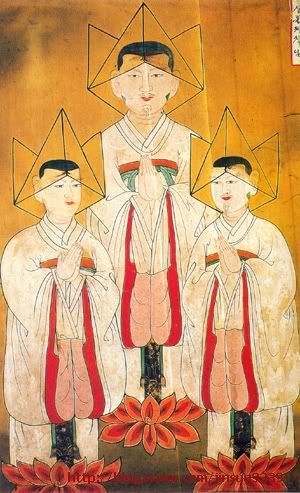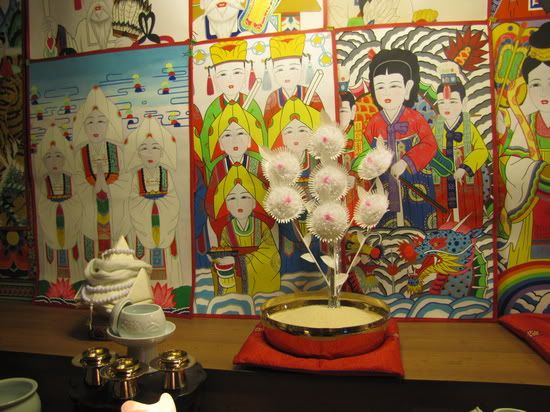Know Your Spirits: Sambul Jeseok (三佛帝釋)
Whether it's from red neon crosses lighting up the night sky or the sound of monks rapping on moktok it is not unusual to encounter evidence of the influence that Christianity and Buddhism have had in South Korea. For someone not specifically looking for them though, it can be much harder to spot the references to Daoism and Shamanism that have also played a role in shaping Korean culture.
Buddhist temples - particularly those situated on mountainsides - may have an area reserved for worship of a local spirit, a 'mountain god' (Hangeul, 산신; Hanja, 山神), and these may include paintings representing various deities associated with Buddhism or Shamanism. In addition to this, shaman-related paintings can also be used in ritual performances known as gut (굿) in Korean. According to Yoon Yeolsu (Yoon 2004:10),
These days paintings of shamanist deities are found more frequently in Hwanghaedo province than in any other regions. Next come Pyeongando, Seoul, and Gyeonggido. The regions with frequent spottings of shamanist paintings correspond to the regions with a heavy population of shamans who are possessed by spirits (Gangsinmu), that often show the signs of ecstasy or possession. In contrast, shamans of Jeollado, Gangwondo, and Chungcheongdo do not use shamanist paintings. Shamans of these regions are basically hereditary shamans (Seseupmu), who do not show the signs of ecstasy or possession.
One image that can be found within shamanist paintings is that of Sambul Jeseok (삼불 제석; 三佛帝釋). Yoon (2009:11) refers to the image as the Buddhist Trinity and says:
The Buddhist/Shamanist Trinity is called Sambul Jeseok and rules from Dorichun (a part of Heaven). It governs child bearing, happiness, and longevity, also interpreted as birth, life, and agriculture. It shares a connection with Tangun, Hwanin, Hwanung, and Hwakum. These three gods are generally depicted wearing triangular, white paper hats, linen clothing, and with their hands together like a Buddhist monk. Most of them have round faces, small lips, and graciously merciful faces, influenced by Chosun Dynasty Buddhism and Shamanism imagery. In Buddhism, at the middle paradise, Amita Buddha (center), Jwabochuh (left saint), and Woobochuh (right saint) exist and they are called the Amita Trinity.
However, Tae-gon Kim's (Kim 1996:238) discussion of the Sambul Jeseok characters includes a more localized origin tale:
Men did not exist on earth until a virgin from heaven named Tanggum Aegi married a divine monk and begot three sons. She later became the goddess of childbirth called Samshin Halmoni and her sons became Sambul Chesok, three heavenly gods ...
Until I turn up additional information concerning which account is more widely accepted I will leave it up to the reader to assess which version carries more historical and cultural currency. Similar to the myriad representations of the Madonna in western art there are also a number of styles in which shamanist deities are depicted. Part of the reason for this is that shamans typically commissioned Buddhist monks (Yoon 2004:11) to create the paintings - resulting in images in a style most familiar to the painter - and also that shamanist paintings are often disposed of in ritual burning ceremonies (Deutsch 2009:23-24) following a gut or upon the death of the shaman. Below are some examples of the Sambul Jeseok trinity that I've found online:

From Wangshimni (왕십리). Source

Source

Source

Source

Source

From Jongno-gu (종로구). Source

The Sambul Jeseok image is located on the left in this photo. Source
Bibliography
Deutsch, Lauren
2009 Don't Buy The Buddha. Theme issue, "Korean Shaman Art," Korean Art Society Newsletter
1(1):23-28Kim, Tae-gon
1996 The Concept of Gods in Korean Shamanism. In Shamanism and Northern Ecology. Juha Pentikäinen,
ed. Pp. 235-247. Berlin: Mouton de Gruyter.Yoon, Yeolsu
2004 [원형을 찾아서 토속신앙의 巫俗畵|Searching for the Origin of Folk Religion -- Paintings of
Shamanism]. Seoul: ICOMYoon, Yeolsu
2009 The Gahoe Museum's Collection of Korean Shaman Art. Theme issue, "Korean Shaman Art,"
Korean Art Society Newsletter 1(1):5-22